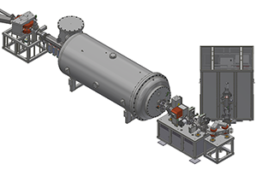Commercial trucks in the U.S. burned approximately 22 billion gallons of diesel fuel in 2010. Replacing diesel with a clean, green and renewable biofuel could substantially reduce the industry’s carbon footprint. Image: Dept. of Transportation |
Researchers with the U.S Department of Energy
(DOE)’s Joint BioEnergy Institute (JBEI) have identified a potential new
advanced biofuel that could replace today’s standard fuel for diesel engines
but would be clean, green, renewable, and produced in the United States. Using
the tools of synthetic biology, a JBEI research team engineered strains of two
microbes, a bacteria and a yeast, to produce a precursor to bisabolane, a
member of the terpene class of chemical compounds that are found in plants and
used in fragrances and flavorings. Preliminary tests by the team showed that
bisabolane’s properties make it a promising biosynthetic alternative to Number
2 (D2) diesel fuel.
“This is the first report of bisabolane as a
biosynthetic alternative to D2 diesel, and the first microbial overproduction
of bisabolene in Escherichia coli and Saccharomyces cerevisiae,”
says Taek Soon Lee, who directs JBEI’s metabolic engineering program and is a
project scientist with Lawrence Berkeley National Laboratory (Berkeley Lab)’s
Physical Biosciences Division. “This work is also a proof-of-principle for
advanced biofuels research in that we’ve shown that we can design a biofuel
target, evaluate this fuel target, and produce the fuel with microbes that
we’ve engineered.”
Lee is the corresponding author of a paper reporting
this research in Nature Communications entitled “Identification and
microbial production of a terpene-based advanced biofuel.” Co-authoring this
paper were Pamela Peralta-Yahya, Mario Ouellet, Rossana Chan, Aindrila
Mukhopadhyay, and Jay Keasling.
The rising costs and growing dependence upon
foreign sources of petroleum-based fuels, coupled with scientific fears over
how the burning of these fuels impacts global climate, are driving the search
for carbon-neutral renewable alternatives. Advanced biofuels are highly touted
for their potential to replace gasoline, diesel, and jet fuels. Unlike ethanol,
which can only be used in limited amounts in gasoline engines and can’t be used
at all in diesel or jet engines, plus would corrode existing oil pipelines and
tanks, advanced biofuels are drop-in fuels compatible with today’s engines, and
delivery and storage infrastructures.
From left, Pamela Peralta-Yahya, Taek Soon Lee, and Mario Ouellet were key members of a team at the Joint BioEnergy Institute (JBEI) that demonstrated the potential of the chemical compound bisabolane to replace D2 diesel. Photo: Roy Kaltschmidt, Berkeley Lab |
“We desperately need drop-in, renewable biofuels
that can directly replace petroleum-derived fuels, particularly for vehicles
that cannot be electrified,” says co-author Keasling, CEO of JBEI and a leading
authority on advanced biofuels. “The technology we describe in our Nature
Communications paper is a significant advance in that direction.”
JBEI is one of three Bioenergy Research Centers
established by the DOE’s Office of Science in 2007. Researchers at JBEI are
pursuing the fundamental science needed to make production of advanced biofuels
cost-effective on a national scale. One of the avenues being explored is
sesquiterpenes, terpene compounds that contain 15 carbon atoms (diesel fuel
typically contains 10 to 24 carbon atoms).
“Sesquiterpenes have a high-energy content and
physicochemical properties similar to diesel and jet fuels,” Lee says. “Although plants are the natural source of terpene compounds, engineered
microbial platforms would be the most convenient and cost-effective approach
for large-scale production of advanced biofuels.”
In earlier work, Lee and his group engineered a new
mevalonate pathway (a metabolic reaction critical to biosynthesis) in both E.
coli and S. cerevisiae that resulted in these two microorganisms
over-producing a chemical compound called farnesyl diphosphate (FPP), which can
be treated with enzymes to synthesize a desired terpene. In this latest work,
Lee and his group used that mevalonate pathway to create bisabolene, which is a
precursor to bisabolane.
“We proposed that the generality of the microbial
FPP overproduction platforms would allow for the biosynthesis of
sesquiterpenes,” Lee says. “Through multiple rounds of large-scale preparation
in shake flasks, we were able to prepare approximately 20 milliliters of
biosynthetic bisabolene, which we then hydrogenated to produce bisabolane.”
When they began this work, Lee and his colleagues
did not know whether bisabolane could be used as a biofuel, but they targeted
it on the basis of its chemical structure. Their first step was to perform fuel
property tests on commercially available bisabolene, which comes as part of a
mixture of compounds. Convinced they were onto something, the researchers then
used biosynthesis to extract pure biosynthetic bisabolene from microbial
cultures for hydrogenation into bisabolane. Subsequent fuel property tests on
the bisabolane were again promising.
“Bisabolane has properties almost identical to D2
diesel but its branched and cyclic chemical structure gives it much lower
freezing and cloud points, which should be advantageous for use as a fuel,” Lee
says. “Once we confirmed that bisabolane could be a good fuel, we designed a
mevalonate pathway to produce the precursor, bisabolene. This was basically the
same platform used to produce the anti-malarial drug artemisinin except that we
introduced a terpene synthase and further engineered the pathway to improve the
bisabolene yield both in E. coli and yeast.”
Lee and his colleagues are now preparing to make
gallons of bisabolane for tests in actual diesel engines, using the new
fermentation facilities at Berkeley Lab’s Advanced Biofuels Process
Demonstration Unit. The ABPDU is a 15,000 square-foot state-of-the art
facility, located in Emeryville,
Calif., designed to help expedite
the commercialization of advanced next-generation biofuels by providing
industry-scale test beds for discoveries made in the laboratory.
“Once the complete fuel properties of hydrogenated
biosynthetic bisabolene can be obtained, we’ll be able to do an economic
analysis that takes into consideration production variables such as the cost
and type of feedstock, biomass depolymerization method, and the microbial yield
of biofuel,” Lee says. “We will also be able to estimate the impact of byproducts
present in the hydrogenated commercial bisabolene, such as farnesane and
aromatized bisabolene.”
Ultimately, Lee and his colleagues would like to
replace the chemical processing step of bisabolene hydrogenation with an alkene
reductase enzyme engineered into the E.coli and yeast so that all of
the chemistry is performed within the microbes.
“Enzymatic hydrogenation of this type of molecule
is a very challenging project and will be a long term goal,” Lee says. “Our
near-term goal is to develop strains of E.coli and yeast for use in
commercial-scale fermenters. Also, we will be investigating the use of sugars
from biomass as a source of carbon for producing bisabolene.”







